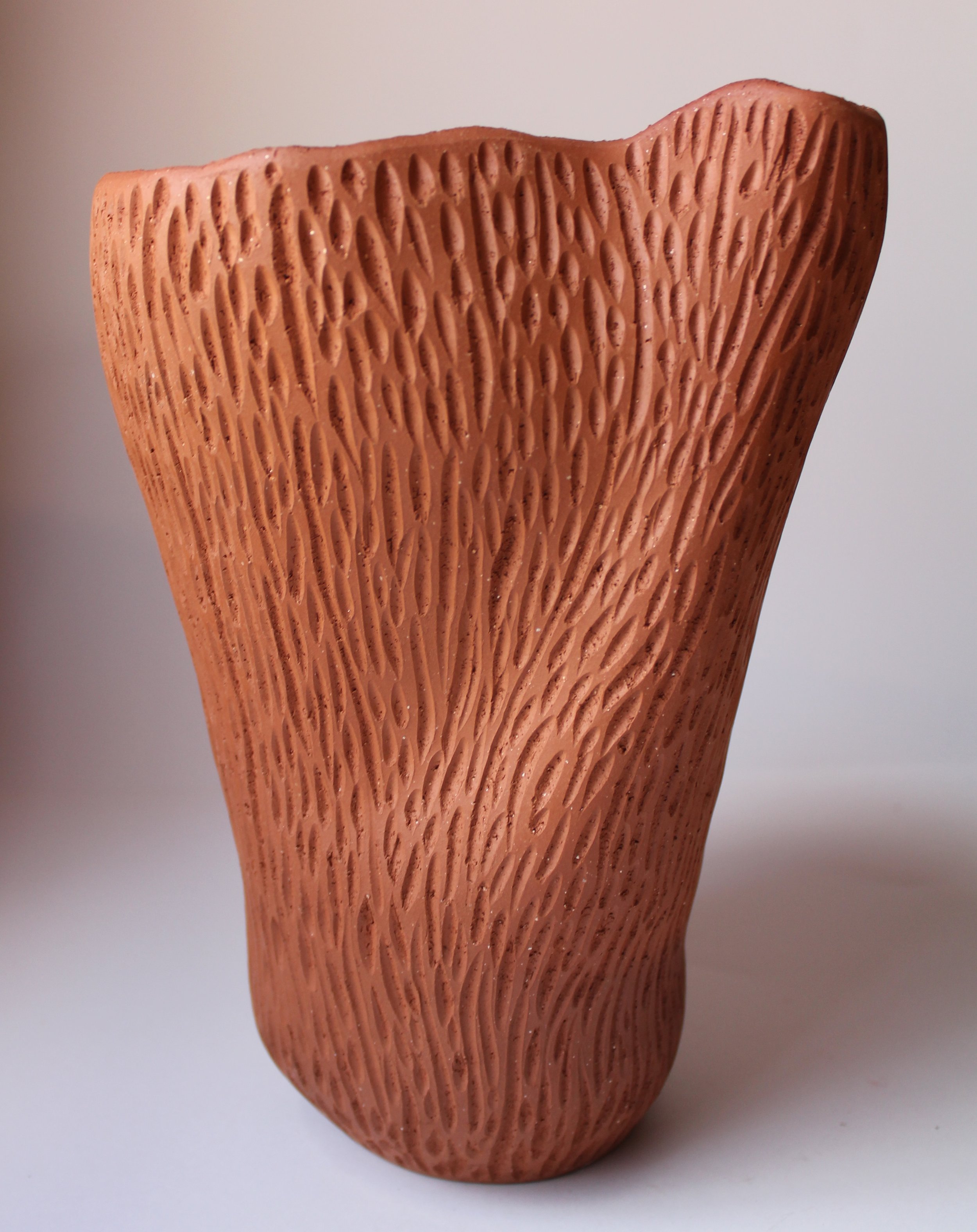 Image 1 of
Image 1 of


Polytrichum Vase, Medium
These clay vases invite you to appreciate the beauty of moss structure, line, and repetition, embodying the spirit of Japanese philsopher Soetsu Yanagi’s observation, “A pattern is a depiction of an object’s quintessential nature.”
By reducing moss to its purest form, woodworker and ceramicist Briana Trujillo captures the species’ enigmatic beauty. The design came about serendipitously; while researching moss, Briana found a photo that drew her eye to the plant’s structure. She noticed a repetition of broken, undulating lines. She then pursued these lines in sketches and three-dimensional prototypes, allowing the form to follow from the lines. The result is a mesmerizing interplay between line and curve, light and shadow. To preserve the warmth of the earthy color, Briana added only a transparent glaze. Like the organic form from which the design takes inspiration, there is no front side. Each angle offers a point of interest.
Briana’s artwork reflects her upbringing. She was born in San Diego, California, where she later attended high school and college, but she spent her childhood in Playa de Tijuana in Mexico. Her work draws inspiration from the colors and flora and fauna of her youth there.
I came across Briana’s work in relation to an exhibition at the Museum for Art in Wood in Philadelphia. The show included one of her pieces, Hélice Dividido, a mounted wood cabinet with a sculptural geometry that seemed lifted from an ice crystal. When I approached her with the idea of creating an object inspired by moss, she came back with the idea of working with clay. What was going to be one object, became three, as her inspiration unfolded.
These clay vases invite you to appreciate the beauty of moss structure, line, and repetition, embodying the spirit of Japanese philsopher Soetsu Yanagi’s observation, “A pattern is a depiction of an object’s quintessential nature.”
By reducing moss to its purest form, woodworker and ceramicist Briana Trujillo captures the species’ enigmatic beauty. The design came about serendipitously; while researching moss, Briana found a photo that drew her eye to the plant’s structure. She noticed a repetition of broken, undulating lines. She then pursued these lines in sketches and three-dimensional prototypes, allowing the form to follow from the lines. The result is a mesmerizing interplay between line and curve, light and shadow. To preserve the warmth of the earthy color, Briana added only a transparent glaze. Like the organic form from which the design takes inspiration, there is no front side. Each angle offers a point of interest.
Briana’s artwork reflects her upbringing. She was born in San Diego, California, where she later attended high school and college, but she spent her childhood in Playa de Tijuana in Mexico. Her work draws inspiration from the colors and flora and fauna of her youth there.
I came across Briana’s work in relation to an exhibition at the Museum for Art in Wood in Philadelphia. The show included one of her pieces, Hélice Dividido, a mounted wood cabinet with a sculptural geometry that seemed lifted from an ice crystal. When I approached her with the idea of creating an object inspired by moss, she came back with the idea of working with clay. What was going to be one object, became three, as her inspiration unfolded.
These clay vases invite you to appreciate the beauty of moss structure, line, and repetition, embodying the spirit of Japanese philsopher Soetsu Yanagi’s observation, “A pattern is a depiction of an object’s quintessential nature.”
By reducing moss to its purest form, woodworker and ceramicist Briana Trujillo captures the species’ enigmatic beauty. The design came about serendipitously; while researching moss, Briana found a photo that drew her eye to the plant’s structure. She noticed a repetition of broken, undulating lines. She then pursued these lines in sketches and three-dimensional prototypes, allowing the form to follow from the lines. The result is a mesmerizing interplay between line and curve, light and shadow. To preserve the warmth of the earthy color, Briana added only a transparent glaze. Like the organic form from which the design takes inspiration, there is no front side. Each angle offers a point of interest.
Briana’s artwork reflects her upbringing. She was born in San Diego, California, where she later attended high school and college, but she spent her childhood in Playa de Tijuana in Mexico. Her work draws inspiration from the colors and flora and fauna of her youth there.
I came across Briana’s work in relation to an exhibition at the Museum for Art in Wood in Philadelphia. The show included one of her pieces, Hélice Dividido, a mounted wood cabinet with a sculptural geometry that seemed lifted from an ice crystal. When I approached her with the idea of creating an object inspired by moss, she came back with the idea of working with clay. What was going to be one object, became three, as her inspiration unfolded.
